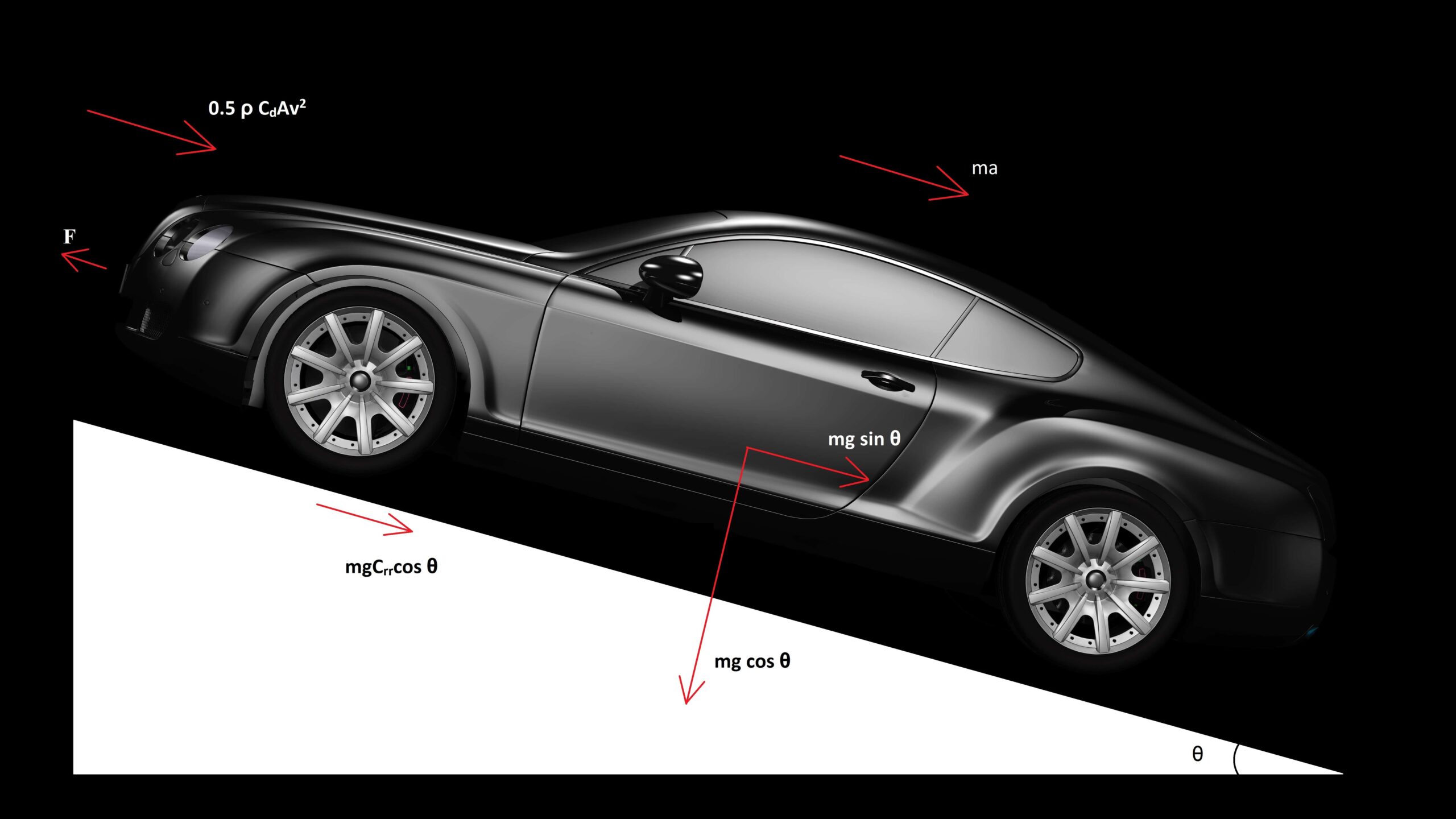

The energy required to travel from a location to another decides how to design an electric vehicle. The constraint of battery to store energy limits the range of the electric vehicle. The information about energy consumption helps to decide the control strategy and to design the components of a hybrid electric vehicle. Selection of motors, the mechanical design of a vehicle, rating of the battery, etc. would be affected by the energy calculation of electric vehicle.
Energy to move an electric car from one location to another mainly includes the following components.
- The energy required to accelerate the vehicle
- Energy to overcome aerodynamic drag
- Energy to overcome friction losses
- Losses in motor, battery, and inverter
If the vehicle decelerates or brakes there are possibilities to recuperate energy which would be used to recharge the battery.
Force acting on a moving car
Basically, a vehicle is a mechanical entity which consumes energy and moves from one place to another. Newton’s equation is applicable for a vehicle to calculate forces associated with it.
Below figure shows the main forces acting on a moving vehicle.

Total force acting on a vehicle up to wheels can be obtained by use of the following equation
where
– acceleration due to gravity in
– mass of the vehicle in
– rolling resistance
– coefficient of aerodynamic drag
– velocity in
– grade angle of road
The above equation consists of four terms and they are explained below.
Friction due to rolling resistance
Friction due to rolling resistance acts on the tire of a vehicle when it moves. It is defined as friction coefficient times the normal force acting on the surface where the wheel rolls. The magnitude of the force depends on the coefficient of rolling friction, mass, and acceleration due to gravity.
Aerodynamic drag
Aerodynamic drag is the force that experiences on a vehicle to overcome the air friction when it travels by pushing air that blocks it in front. The shape of the vehicle, frontal area, aerodynamic drag coefficient, and velocity of the vehicle affects the force.
Force to accelerate vehicle
The force that accelerates vehicle is proportional to mass and acceleration of the vehicle. It would come to the picture if the vehicle accelerates. If a vehicle decelerates this force will be negative and energy associated would be dissipated in the braking system to stop the vehicle. This energy can be stored in battery with regenerative braking.
Simplified equation
If the grade of road is assumed to be flat (θ = 0) it removes the last term from the equation and modifies the first term as well. Then the simplified equation to calculate the force required at the wheels of a vehicle would be
Above equation best suits for driving cycles with a flat road.
Product of force and velocity results in instantaneous power requirement of the vehicle. Knowledge of velocity of the vehicle at each time instant is needed to calculate force, power, and energy to move the vehicle. Driving cycle, which is velocity vs time graph of a vehicle plays its role here. Data such as the gradient of the road also incorporated in the driving cycle.
You can read “What are driving cycles and how to develop one for EV simulation?“
Energy consumption of an Electric Vehicle
With the help of a driving cycle, the power required at the wheels of a vehicle is calculated. And the time integral would give the energy consumption to move the vehicle in that given driving cycle.
Using backward facing calculation, the energy consumption of each stage of the vehicle starting from wheels to the battery will be calculated. Firstly energy consumption up to the wheels for a given driving cycle will be calculated as explained above. The battery is responsible to supply energy requirement at wheels in an electric vehicle. In a conventional vehicle, the internal combustion engine does the duty.
Selection EV battery rating
Along with requirement at wheels, battery would meet losses in gear, motor, inverter, and battery.
Read more about Electric vehicle motor
Mathematical models of above-mentioned elements can be used for loss calculation. Simulation software gives a model for vehicle simulation or we can develop the model of an inverter, motor, and battery for electric vehicles.
Since inverter efficiency doesn’t show much variation with load, assumptions can be made in calculations to reduce mathematical complexity. Assumptions of reasonable values for the efficiency of motor, inverter, battery, and wheels might give acceptable results with reduced accuracy.
Selection of capacity of the battery, ratings of power electronic components, mechanical design optimization to minimize aerodynamic drag, etc. are a few advantages of energy calculation of electric vehicle.
Conclusion
Energy consumption of an electric vehicle affects the range of the vehicle. The total distance that could travel by an EV with a fully charged battery can be analyzed based on the energy consumption of the vehicle.

Pretty! This was a really wonderful article. Thanks for providing these details.